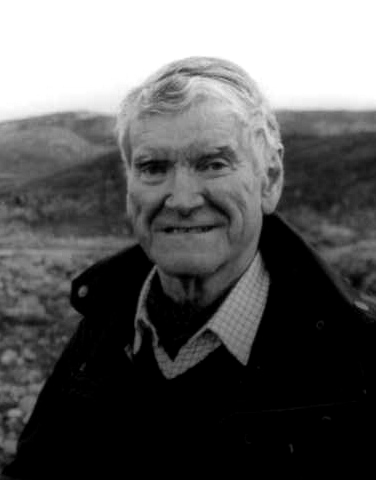



Biography
James Houston

James Houston, author, designer, and filmmaker, was born in Toronto in 1921. He studied art at age 11 with Arthur Lismer at what is now the Art Gallery of Ontario, and later at the Ontario College of Art. After the war, he studied life drawing in Paris at the Academie de la Grande Chaumiere and engraving at Atelier 17 with William Hayter. In 1958-59, he studied printmaking with Unichi Hiratsuka in Tokyo.
After five years of wartime service with the Toronto Scottish Regiment (Canadian Active Service Medal '40-'45), he went in 1948 into the Canadian Eastern Arctic in search of a new people and a new land to paint. He then worked through the Canadian Guild of Crafts, the Federal Government and the Hudson's Bay Company to bring to the attention of the outside world the flourishing Inuit sculpture of stone, bone and ivory carving. Houston was for nine years Northern Service Officer and Civil Administrator of West Baffin Island in the Northwest Eskimo Co-operative. Mr. Houston lived in the Canadian Arctic from 1948-82. He continues to visit the Canadian North and Alaska each year on various projects, and lectures widely on Inuit and Indian art and culture.
James Houston divides his time between a colonial house in Connecticut built by a famous privateer, a writing and fishing retreat on the Queen Charlotte Islands, British Columbia, and New York City where he is master designer for Steuben Glass. His sculptures, in crystal, metal and plexiglass, along with his drawings and paintings, are in museums and private collections throughout the world. His designs often use an Arctic or wildlife theme. His sculpture, Aurora Borealis, a 70-foot work of polished prismatic spheres, is on permanent display in the central staircase at the Glenbow Museum in Calgary. He designed the National Geographic Centennial Award. In 1970, he won the Chicago Book Clinic design award.
He is the author and illustrator of 17 books for children, half of which have won international book awards. He has three times won the Book of the Year for Children Medal from the Canadian Library Association (1966, 1968, 1980), twice the Canadian Authors Association Metcalf Award (1977, 1981), Canada Council's Children's Literature Prize (1986), B.C. Book Prize (1987), and the American Library Association Notable Book Award (1967, 1968, 1971, 1977). He has twice been the nominee from Canada for the Hans Christian Andersen Award, Ibby (1987, 1991). Titles of his children's books are: Tiktla'liktak, Eagle Mask, The White Archer, Akavak, Wolf Run, Songs of the Dream People, Ghost Paddle, Kiviok's Magic Journey, River Runners, Long Claws, the trilogy: Frozen Fire, Black Diamonds, and Ice Swords, also The Falcon Bow, Whiteout, winner of the 1989 Max and Greta Ebel Memorial Award, and Drifting Snow, published in 1992, nominated for the Governor General's Literary Award and the Silver Birch Award of the Ontario Library Association. Fire Into Ice is a non-fiction book about glassmaking.
Houston's novel, The White Dawn, a Book-of-the-Month Club main selection, was published in 11 languages, 31 editions, and adapted to his screenplay for a feature for Paramount Pictures. His adult novel, Spirit Wrestler, also concerns the Inuit of Baffin Island. Ghost Fox, for which Houston also wrote the screenplay, is set in Canada and New England during the French and Indian Wars. His novel, Eagle Song tells of Northwest Coast Indians in the early 19th century. Running West is the story of Thanadelthur, a Dene woman, and William Stuart, a Hudson's Bay Company post servant, and their exciting journey through unknown lands. For this book, Houston received the 1990 Canadian Authors Association Literary Award for Fiction. His most recent novel is The Ice Master. His memoirs are Confessions of an Igloo Dweller and Zigzag: A Life On the Move.
Houston is the producer and director of the documentary films: So Sings the Wolf, Kalvak, Legends of the Salmon People, and Art of the Arctic Whalemen for the Devonian Group, Alberta-Glenbow Art Museum. He has made a series of limited animation films of native legends for NBC, and was technical advisor for documentaries, including The Living Stone and Kenojuak,, with the National Film Board of Canada, and The Legend of the Raven with Crawley Films. For his work with documentary films, he has shared in the winning of 26 international film awards.
In 1966, James Houston was given the American Indian and Eskimo Cultural Foundation Award, Washington, D.C., and he was given the Inuit Kuavati Award of Merit in 1979. He served on the Selection Committee for the Inukshuk Sculptures for the Toronto International Airport, 1962, and the Selection Committee for the Sculpture Inuit International Exhibition, 1972. He received the Queen Elizabeth Silver Anniversary Medal, 1977, "For outstanding personal achievement." The Royal Canadian Geographical Society awarded him the 1997 Massey Medal.
Houston was given the degree of Doctor of Literature, honoris causa, by Carleton University, Ottawa, in 1972, for his: "great contribution to the art and welfare of the native people of Canada." He was appointed Officer of the Order of Canada, is a Fellow of the Royal Society of Arts and honorary member of the College of Fellows of the Royal Canadian Geographical Society. He was awarded the degree Doctor of Humane Letters from Rhode Island College, 1975, and the degree Doctor of Fine Arts from the Rhode Island School of Design, 1979, and was made Honorary Fellow, Ontario College of Art, 1981. Dalhousie University conferred upon Houston the degree Doctor of Laws, 1987, and in the same year he was chosen to deliver the May Hill Arbuthnot Honor Lecture in the field of children's literature, and received the Citation of Merit Award from the Royal Canadian Academy of Arts. In 1992, he was selected among the 125 most significant Canadians in the country's 125-year history. At Rhode Island College, he established the James Houston Award in Anthropology/Geography.
| Home | Current Titles | Coming Soon | Contact Us | Profiles | Awards | Order |